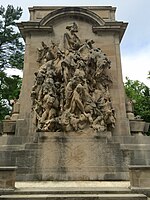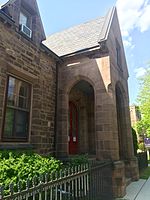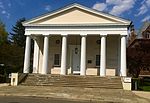Morven (Princeton, New Jersey)
Biographical museums in New JerseyFormer governors' mansions in the United StatesGovernor of New JerseyHistoric district contributing properties in Mercer County, New JerseyHistoric house museums in New Jersey ... and 9 more
Houses completed in 1730Houses in Princeton, New JerseyMuseums in Princeton, New JerseyNRHP infobox with nocatNational Historic Landmarks in New JerseyNational Register of Historic Places in Mercer County, New JerseyNew Jersey Register of Historic PlacesStockton family of New JerseyUse mdy dates from August 2023

Morven, known officially as Morven Museum & Garden, is a historic 18th-century house at 55 Stockton Street in Princeton, New Jersey. It served as the governor's mansion for nearly four decades in the 20th century, and has been designated a National Historic Landmark for its association with Richard Stockton (1730-1781), a signer of the United States Declaration of Independence.
Excerpt from the Wikipedia article Morven (Princeton, New Jersey) (License: CC BY-SA 3.0, Authors, Images).Morven (Princeton, New Jersey)
Stockton Street,
Geographical coordinates (GPS) Address External links Nearby Places Show on map
Geographical coordinates (GPS)
| Latitude | Longitude |
|---|---|
| N 40.347491666667 ° | E -74.666952777778 ° |
Address
Morven Museum
Stockton Street 55
08540
New Jersey, United States
Open on Google Maps










